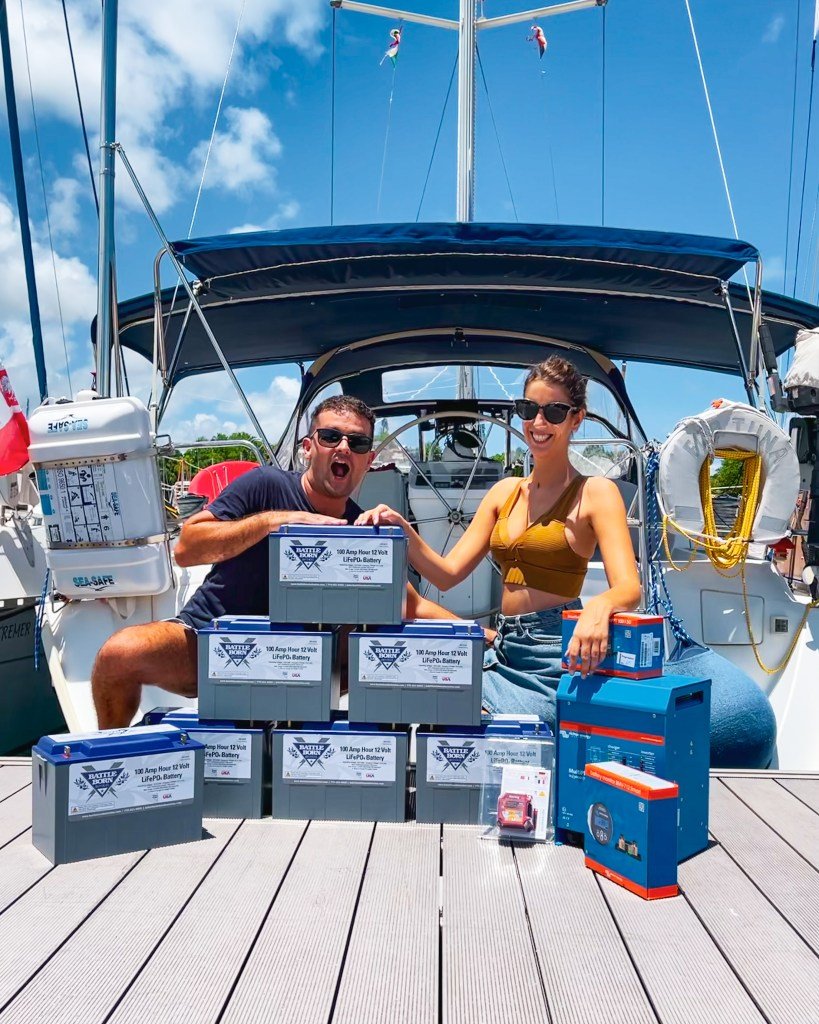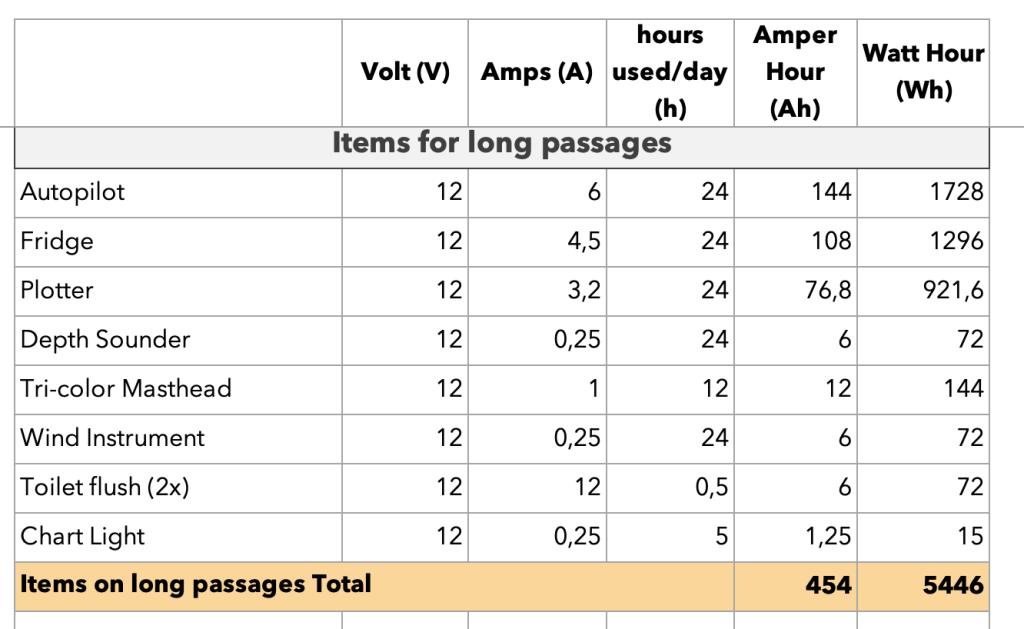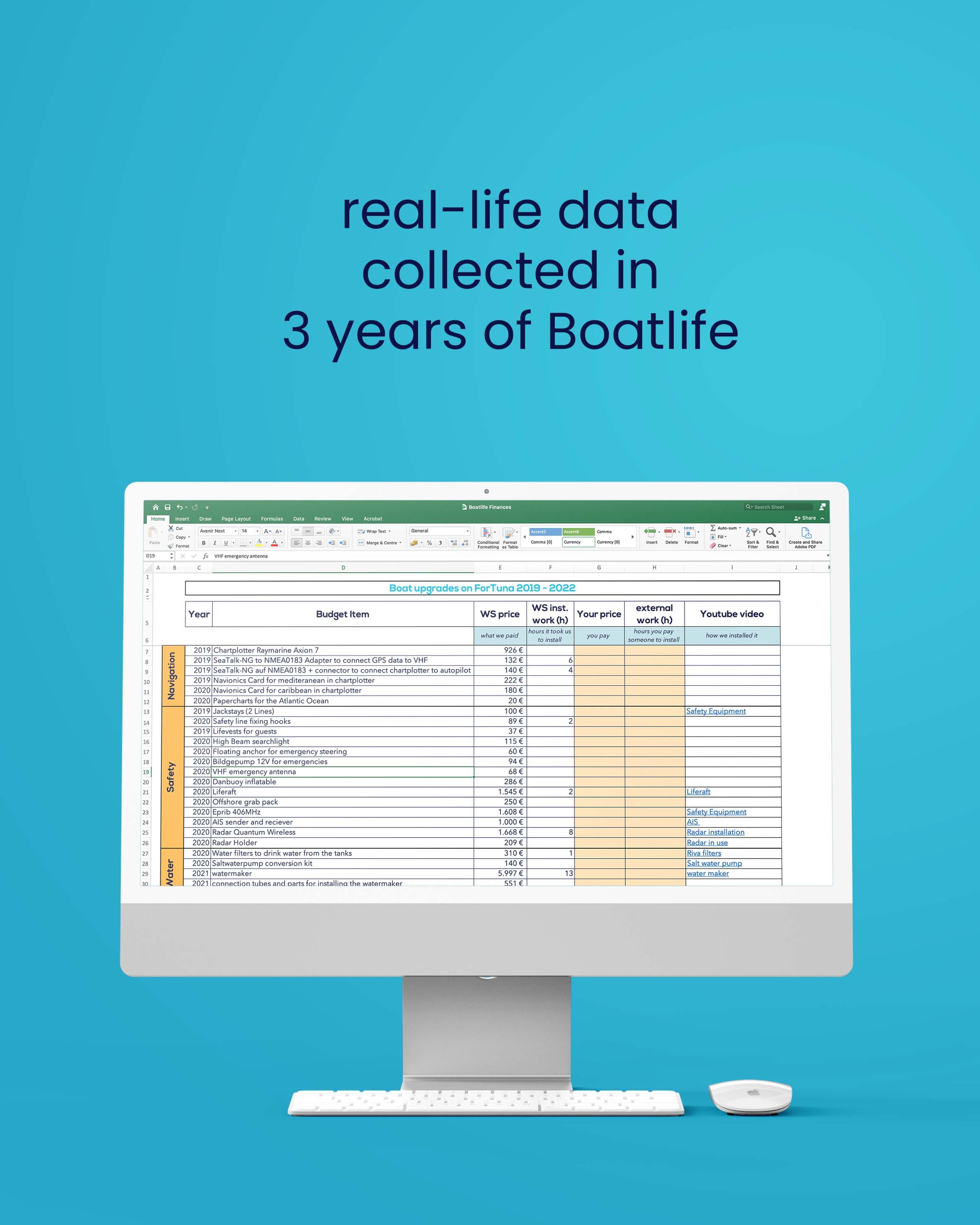Electrical needs on cruising sailboats (determine your power consumption)
How much electricity do you need on a sailboat?
When we started our Boatlife about 4 years ago on ForTuna, we had spare knowledge on the power consumption we would have to be self-sufficient on our sailboat. Our initial system included:
180 W flexible solar panels
600 W alternator on the motor
2x 180Ah lead acid truck batteries to store the energy
Soon we would discover that this would not be enough for the off-shore lifestyle we aimed for. Especially during cloudy or rainy days or during winter, we were draining our batteries continuously. But how did we determine what changes to make in our electrical boat set-up to achieve our off-grid dream? How did we calculate the power consumption on our sailboat? This blog post has the answers to these questions. We will help you understand how much power you use and how to set up your marine energy system. If you do not know what the electric set-up on a sailboat includes, read our Boat Electricity 101 before diving deeper into the topic.
Step 1 - Marine Battery needs for cruiser
If you are running low on electricity on board, there are 2 actions you can take: instal more electricity generators, whether solar, wind or fuel ones or install more batteries. However, before we can define how much energy we need to generate and how to store it, we need to understand what we use the power for and how much of it we use.
How to determine the power consumption on a sailboat?
To determine the power consumption on our sailboat, we’ve compiled an energy balance excel sheet with all the electrical devices we have on board.
Devices that continuously run, like the fridge or water system,
Variable devices on 12V that need to run during the day, the night or while sailing and long passages
Variable devices on 230V that we need for Boatlife, like our laptops or the washing machine
The energy balance is needed to dimension the battery bank and to choose the necessary equipment (solar panels, wind generator etc.) to produce the required electricity for daily onboard consumption. It should include the operating power (Watt) for each electrical device and an estimate of the utilisation time for each piece of equipment over 24 hours.
Example: for a piece of equipment consuming 10 watts of power during 3 hours per day, the daily energy will be 30 Wh (10W x 3 hours).
Download our energy balance sheet for reference - Our list is based on a 12V system and the hours used per day are based on our experience.
The most significant chunk in our case was the fridge, for the simple fact that it runs continuously. With our old battery bank on hot summer days, the refrigerator would overheat and drain the batteries. On such days we would not even be able to charge our laptops to work.
How many marine batteries do you need for off-shore cruising?
The size of your Battery bank depends on:
your average power consumption (Wh - energy balance sheet)
the number of energy generators you have (solar, wind, fuel)
the timeframe you want to stay self-sufficient
1. Our energy balance calculations resulted in approximately 5000 Wh daily power consumption. It might seem like a high consumption but keep in mind our goal is to work and live full-time in remote areas and we included "dream" items in our calculations, such as a freezer or an electric cooktop. We currently do not have them on board but hope to install them one day on ForTuna, so it was important to set up the battery system for them too.
Moreover, we based our energy consumption calculations on long-distance passages because we wanted to take more of those in the upcoming years. We sailed across the Atlantic ocean with our “old” power set-up and knew how draining long-distance passage are on your electrical system. Having the autopilot and all safety systems on 24/7 requires a lot of energy.
2. While it might be straightforward to determine your power consumption, calculating your electric energy production can be challenging, especially when you rely on renewable energies like solar and wind. Instead of trying to come up with a number, we decided to take the worst-case scenario approach. If all our energy production devices would stop working, how many hours do we want to be self-sufficient?
Working and living full-time in remote areas meant our system needed to support us even if recharging was impossible for days. Obvisuoly we needed to find a balance between space, budget and the ideal battery bank. We settled for 30h of continuous usage of working and living full time on a longe passage as final set-up. The above image shows you the calculations behind our reasoning. Both for our old lead batteries set-up and for our new lithium battery set-up. If you want to know the difference between the types of marine batteries please read more here.
calculate your power consumption
Step 2 - Energy supply on a sailboat
A big battery bank has no use if you can not charge them. The second step in designing the electrical set-up on a boat is to define your electrical generators.
The electrical needs we calculated above are all maximum usage scenarios. On an average day, we would rarely hit them, and so far, we rarely managed to drain the batteries lower than 50%! But to keep it that way, we had to upgrade our charging system from 180W solar to 600 W solar and 400 W wind. We love the combination of solar and wind generators because either sun or wind is always present. Solar is an excellent energy source during the day and on sunny days, but we can rely on our wind generator during the night and on stormy days. Especially the fact that the wind generator is producing during the night felt like a revelation. After two years of relying on solar energy, waking up to charged or less drained batteries was refreshing.
According to the ideal calculations, our system would need 800W of solar and 600W of wind to ensure the batteries are always full. These calculations are based on recommendations made by BattleBornBatteries, which is the marine lithium battery supplier we chose. They recommend that a 100Ah deep cycle battery will need 180 watts of solar to fully charge, assuming you have at least four hours of sunlight daily. Thus, if you have a 200Ah battery bank, you'll need at least 360 watts of solar. In this case, two 200-watt panels would satisfy your electricity needs. If you want to ensure you have enough "generators" on board, check in with the battery producer you chose.
How much does it cost to live on a sailboat?
Step 3 - Bring it all together
The electrical set-up on a boat comprises more than energy storage and generators. It also includes inverters, fuses, switches and a looooot of cable. To properly design your power set-up, look at your current set-up and review the questions below. These questions are based on our experience installing the electrical set-up on ForTuna. If you do not have basic electrical knowledge, please refer to a specialist to avoid inquiries or damage.
Is your system based 12v or 24V?
Service and starter battery layout: are both charged by the alternator through a splitter? Do you use a dc/dc charger to charge the starter battery from the house bank (not recommended)? Should you connect solar panels only to service batteries?
Emergency systems: bilge pump etc. connected directly to the batteries?
Bow thruster, anchor windlass or other high-energy drawing items: should they be connected separately or have a dedicated battery bank?
Shore power and battery charger: is shore power still needed? What is charging the batteries through shore?
Inverter: how much kW do you need? Do you connect all 220V outlets? Disconnect shore power?
Battery management: integrated BMS in the batteries? Do we need a battery monitor? At which charge percentage should the alarm go off?
Charging solutions: are your existing wind and solar chargers ready to switch to Lithium?
Cable distances: how long can the cables before you lose too much energy? (Victron ToolKit App)
Alternator protection: is the device necessary to prevent overheating with Lithium?
Switches, fuses: is everything you have already rated for more energy? What are the right fuses to use for Lithium?
Bus bars to connect multiple batteries: how to choose the proper size and how to connect them?
Okay this blog post did definitely turn out longer than expected. If you have any more questions feel free shoot us a message at info@whensailing.com.















